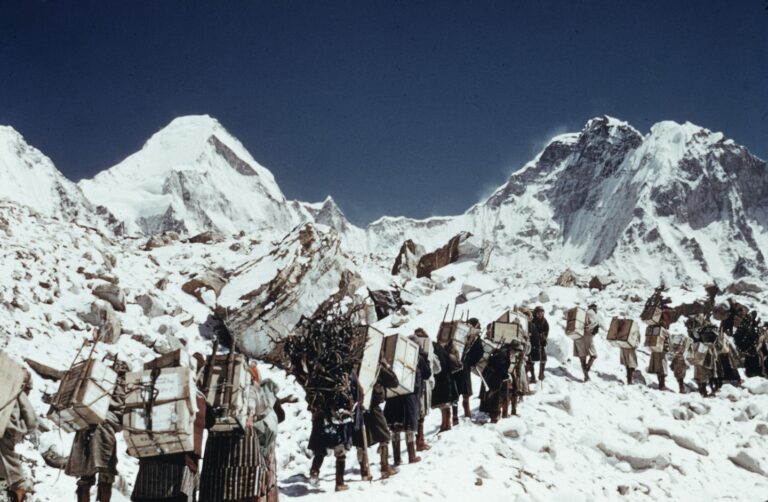Or so it appeared then. “Everest, Inc.: The Renegades and Rogues who Constructed an Business on the Prime of the World,” by Will Cockrell, tells the story of how these inconceivable and lethal heights have now been summitted, according to one recent count, 11,966 instances by 6,664 individuals. The overwhelming majority of them are shoppers who pay upward of six figures for the privilege of being led up the mountain clutching prefixed rope handrails, respiratory bottled oxygen cached by others, after a number of weeks of dwelling in a sprawling base camp metropolis of 1000’s in carpeted, heated and well-fed luxurious. Some notably high-end shoppers begin acclimatizing weeks early in plastic bubbles delivered to their houses. Latest summiteers have included blind individuals, two 13-year-olds, septuagenarians and even double amputees.
Making Everest as simply bought as a Caribbean cruise didn’t occur instantly. For years after 1953, the mountain remained a singular check of alpine ability and endurance. Jim Whittaker turned the primary American to summit in 1963; Reinhold Messner the primary to summit with out supplemental oxygen in 1978. Within the early Eighties, two occasions coincided. Lou Whittaker, Jim’s twin brother, himself an elite climber and proprietor of a guiding service, determined to aim Everest by way of a primary ascent of the North Wall, a brand new and tough route. And a wealthy, middle-aged Texan named Dick Bass, creator of Snowbird Ski Resort, hatched an thought to climb the very best peak on every of the seven continents. Whittaker wanted $180,000to fund his expedition and Bass agreed to fund your entire factor — if he acquired to tag alongside. “It was the unlikeliest of alliances,” Cockrell writes. “No mountain information had ever introduced somebody to Everest earlier than, bearing specific accountability for that individual’s success and security.”
Bass reached the summit on his third strive, in 1985 on the age of 55, thanks largely to all the cash he’d thrown on the endeavor. “The legend of Dick Bass was born not within the second when he staggered into Everest base camp safely,” Cockrell writes. “It was when the person they referred to as Giant Mouth Bass started telling tales [and] the entire thought of climbing Everest started to vary within the public eye.” There was no unseeing it: This staggeringly tough athletic feat that cash couldn’t purchase was a commodity in any case.
“Everest, Inc.” is an apt title, as a result of the story it tells is finally a enterprise one — how Western climbing guides turned Everest from a feat of will and talent into one among logistics. Know-how made oxygen lighter and extra dependable, with a lot greater circulate charges, and the mountain’s fickle climate extra predictable. Posher camps enabled weaker climbers extra relaxation. Sherpas, previously used as high-altitude beasts of burden, turned expert alpinists; one named Kami Rita Sherpa has summited the height 29 instances. Everest was thus decoded: In 1993 alone, extra climbers reached the highest in a single season than within the 26 years after the primary ascent.
In fact, demise lurked. When Bass met Whittaker, extra individuals had died attempting to summit than had made it. To a sure sort of individual, it seems, there’s no headier attract. The eight who perished through the 1996 season, an occasion exhaustively lined by the sort of magazines Cockrell has lengthy written for — amongst them, Exterior and Males’s Journal — after which in Jon Krakauer’s “Into Skinny Air,” solely amped the climb’s reputation. “To the potential shoppers, the potential for demise was a chance for rebirth,” Cockrell writes. “All our journeys crammed up after [the 1996 deaths,]” a information instructed him. “I felt like I might promote a penny-size Everest rock for fifteen grand.”
Is all of this Everest entry a great factor? Because the creator of a e book in regards to the guides and the guiding business that introduced this modification, Cockrell doesn’t have a lot selection in answering; for him it’s a tough sure. It’s nonetheless the world’s highest mountain, in any case, with all that entails — hazard, effort, a profound expertise (regardless of how lowered) that takes weeks, a killer view. Why shouldn’t anybody get to expertise that? But it surely’s arduous not to have a look at these photos of shoppers stacked on the aspect of the mountain in lengthy traces, clutching their handrails and never suppose, Gross. That one thing elementary to exploration and journey and the human expertise of it has been misplaced, is misplaced; that the factor they’ve bought is a factor so vastly totally different from its very thought as to render it meaningless.
“Everest, Inc.” feels too rah-rah in assist of the business, typically, and it might have been a greater e book if Cockrell had slowed down and plumbed these philosophical questions extra deeply. There are additionally too many names — I counted 39 on one web page alone — and it’s odd that he by no means delves into the dramatic enlargement of helicopters that abets each rescuing shoppers and logistics. But there may be additionally a way more latest a part of the Everest story that’s essential and highly effective: the gradual awakening of Sherpas themselves to their function and abilities — and lengthy exploitation — on the mountain. In a historical past inextricably woven with colonialism and empire, Everest has lastly develop into a largely Nepalese enterprise. The 5 largest firms working on the mountain are actually owned, staffed and guided by Nepalese. If somebody goes to make a buck out of promoting the as soon as revered icon, it’d as properly be the locals.
Carl Hoffman is the creator of 5 books, together with “Liar’s Circus,” “The Final Wild Males of Borneo” and “Savage Harvest.”
The Renegades and Rogues Who Constructed an Business on the Prime of the World


